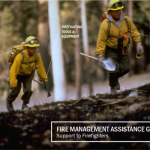ATLANTA, Ga.–The U.S. Department of Homeland Security’s Federal Emergency Management Agency (FEMA) has authorized federal funds to reimburse costs to Georgia to fight the Tatum Gulf Fire burning in Dade County.
This authorization makes FEMA grant funding available to reimburse 75 percent of the eligible firefighting costs for managing, mitigating and controlling the fire. Eligible costs can include labor, equipment and supplies used for fighting the fire and costs for emergency work such as evacuations and sheltering, police barricading and traffic control.
“FEMA has approved this request to make sure Georgia has the resources it needs to battle this fire,” said FEMA Regional Administrator Gracia Szczech. “We will continue to work closely with the frontline responders who are fighting this wildfire.”
The state requested a Fire Management Assistance Grant (FMAG), and it was granted in the late evening of November 13, 2016. The fire started on November 11, and at the time of the request, had burned more than 250 acres of state and private land. The fire was threatening 150 homes in and around the City of Trenton and the Rising Fawn community. In addition, the fire is threatening utility lines, a communications tower, roads, and cultural resources. Currently, mandatory evacuations are taking place for approximately 200 people (60 homes) and evacuations are expected to continue.
Federal fire management assistance is provided through the President’s Disaster Relief Fund and made available by FEMA to fund firefighting activities when there is a fire threat that could cause a major disaster. Eligible state firefighting costs covered by the aid must first meet a minimum threshold for costs before assistance is provided.
###
FEMA’s mission is to support our citizens and first responders to ensure that as a nation we work together to build, sustain and improve our capability to prepare for, protect against, respond to, recover from and mitigate all hazards.
Download the FEMA mobile app for disaster resources, weather alerts, and safety tips.
See original article here:
FEMA Authorizes Federal Funds to Help Battle Georgia Wildfires





